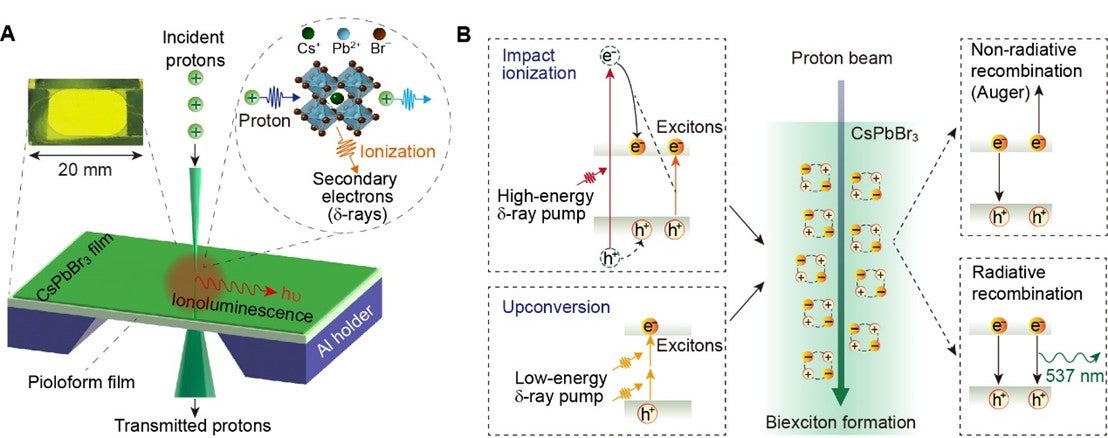
A research team led by Professor LIU Xiaogang from the Department of Chemistry and Associate Professor Andrew BETTIOL from the Department of Physics, NUS demonstrated the real-time detection and counting of single protons using thin-film transmissive scintillators made of CsPbBr3 nanocrystals. This approach offers unparalleled sensitivity with a light yield approximately double that of commercially available BC-400 plastic thin-film scintillators and ten times greater than conventional bulk scintillators such as LYSO:Ce, BGO and YAG:Ce crystals.
Their findings have been published in the journal Nature Materials.
The thin-film nanocrystal scintillators, with a thickness of approximately 5 µm, exhibit high sensitivity that allows for a detection limit of 7 protons per second. This sensitivity is about five orders of magnitude lower than clinically relevant counting rates, making it a significant advancement in single-proton detection technology.
The research team has put forward and substantiated a novel theory regarding the scintillation mechanisms induced by protons in CsPbBr3 nanocrystals. They have verified that proton-induced scintillation primarily arises from the population of the biexcitonic state in CsPbBr3 nanocrystals, facilitated by the process of proton-induced upconversion and impact ionisation. This finding represents a significant contribution to the understanding of proton scintillation in perovskite nanocrystals.
By utilising the enhanced sensitivity, together with the fast response (~336 ps) to proton beams and pronounced iono-stability (up to a fluence of 1014 protons per cm2), the reseachers demonstrated additional applications of the CsPbBr3 nanocrystal scintillators. These include single-proton tracing, real-time patterned irradiation and super-resolution proton imaging. Remarkably, their study has showcased a spatial resolution of sub-40 nm for proton imaging; this holds tremendous promise for advancing various fields, such as materials characterisation, medical imaging and scientific research.
Prof Liu said, “The breakthrough presented in this work would be of considerable interest to particle radiation detection communities, offering both fundamental insights into new mechanisms of proton scintillation and technical advances in groundbreaking single-ion detection sensitivity using ultrathin proton-transmissive scintillators. In particular, these CsPbBr3 nanocrystal scintillators hold overwhelming promise for advancing detection technology in proton therapy and proton radiography.”
Read the full article here.

Figure (A) shows the schematic of proton-beam-induced luminescence (ionoluminescence) in a transmission thin scintillator comprising CsPbBr3 nanocrystals (cubic structure), and proton-induced ionisation to produce secondary electrons (δ-rays). Figure (B) presents the proposed mechanism of proton scintillation, including high-density exciton formation via proton-induced upconversion pumped by low-energy δ-rays and impact ionisation pumped by high-energy δ-rays (left panel), biexciton formation via exciton-exciton interaction (middle panel), and de-excitation processes via radiative recombination of biexcitons accompanied by a fast non-radiative Auger process (right panel). [Credit: MI Zhaohong].
